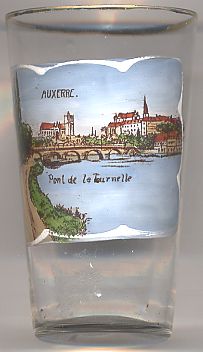

|
| FRANCE | FRANCE |
| région: Bourgogne-Franche-Comté | |
| département: 89, Yonne |
 Auxerre is situated at an elevation of 102 m on the river Yonne in the région Bourgogne-Franche-Comté of France.
Auxerre is the capital (préfecture) of the département Yonne. The municipality has a population of about 37,400 (2006).
Auxerre is situated at an elevation of 102 m on the river Yonne in the région Bourgogne-Franche-Comté of France.
Auxerre is the capital (préfecture) of the département Yonne. The municipality has a population of about 37,400 (2006).
Auxerre was a flourishing Gallo-British centre, Antissiodorum, through which passed one of the main roads of the area, the Via Agrippa (1st century AD)
which crossed the Yonne River (Gallo-Roman Icauna) here. In the third century it became the seat of a bishop and a provincial capital of the Roman Empire.
In the 5th century it received a Cathedral. In the late 11th/early 12th century the existing communities were included inside a new line of walls built by the
feudal Counts of Auxerre.
Bourgeois activities accompanied the traditional land and wine cultivations starting from the twelfth century, and Auxerre developed into a commune with a
Town Hall of its own. The Burgundian city, which became part of France under King Louis XI, suffered during the Hundred Years' War and the Wars of Religion.
In 1567 it was captured by the Huguenots, and many of the Catholic edifices were damaged. The medieval ramparts were demolished in the 18th century.
In the 19th century numerous heavy infrastructures were built, including a railway station, a psychiatric hospital and the courts, and new quarters were
developed on the right bank of the Yonne. In 1995 it was named "Town of Art and History".
[Text adapted from http://en.wikipedia.org/wiki/Auxerre]
Most of the  Cathédrale Saint-Étienne d'Auxerre [left]
was built 1215–1233 in Burgundian Gothic style, over an 11th-century crypt, but building continued until the 1540s, when the cupola in Renaissance style
that takes the place of one pinnacle on the completed tower was completed. The first building campaign erected the chevet at the liturgical east end, followed
later in the century by a new façade and the bases of new towers at the west end, still linked to the apse end by the nave of the old cathedral. Construction
on the nave and transepts proceeded slowly through the 14th and 15th centuries.
Cathédrale Saint-Étienne d'Auxerre [left]
was built 1215–1233 in Burgundian Gothic style, over an 11th-century crypt, but building continued until the 1540s, when the cupola in Renaissance style
that takes the place of one pinnacle on the completed tower was completed. The first building campaign erected the chevet at the liturgical east end, followed
later in the century by a new façade and the bases of new towers at the west end, still linked to the apse end by the nave of the old cathedral. Construction
on the nave and transepts proceeded slowly through the 14th and 15th centuries.
[Text adapted from http://en.wikipedia.org/wiki/Cathédrale_Saint-Étienne_d'Auxerre]
The  Abbaye Saint-Germain d'Auxerre [right]
was a Benedictine monastery in southern France, dedicated to its founder St. Germain of Auxerre, the bishop of Auxerre, who died in 478. The abbey reached
the apex of its cultural importance during the Carolingian era; the source for its early history is an account of the Miracula Sancti Germani Episcopi Autissiodorensis
("Miracles of Saint Germain, Bishop of Auxerre") written before ca.880. The earliest surviving architectural remains are also of the 9th century.
In 1927, beneath the 17th-century frescoed plaster walls of the crypt, were discovered ninth-century wall frescoes, the only surviving large-scale paintings
of their date in France to compare to the illuminated manuscripts.
During the Revolution, several bays of the nave were demolished and the secularized abbey was used as a hospital. The former nave extended beneath the present forecourt.
In the late twentieth century the abbey's residential and service buildings were remodeled as a museum, presenting prehistoric, Gallo-Roman and medieval finds from Auxerre.
Abbaye Saint-Germain d'Auxerre [right]
was a Benedictine monastery in southern France, dedicated to its founder St. Germain of Auxerre, the bishop of Auxerre, who died in 478. The abbey reached
the apex of its cultural importance during the Carolingian era; the source for its early history is an account of the Miracula Sancti Germani Episcopi Autissiodorensis
("Miracles of Saint Germain, Bishop of Auxerre") written before ca.880. The earliest surviving architectural remains are also of the 9th century.
In 1927, beneath the 17th-century frescoed plaster walls of the crypt, were discovered ninth-century wall frescoes, the only surviving large-scale paintings
of their date in France to compare to the illuminated manuscripts.
During the Revolution, several bays of the nave were demolished and the secularized abbey was used as a hospital. The former nave extended beneath the present forecourt.
In the late twentieth century the abbey's residential and service buildings were remodeled as a museum, presenting prehistoric, Gallo-Roman and medieval finds from Auxerre.
[Text adapted from http://en.wikipedia.org/wiki/Abbey_of_Saint-Germain_en_Auxerre]
The  Pont de la Tournelle [centre left foreground] spans the river Yonne.
The bridge was built in 1866–1869 and was initially called Pont Neuf. The name of the bridge is derived from a tower that protected a
corner of the town's fortification. The bridgehead at the left bank of the river was built on the foundations of the old tower.
Pont de la Tournelle [centre left foreground] spans the river Yonne.
The bridge was built in 1866–1869 and was initially called Pont Neuf. The name of the bridge is derived from a tower that protected a
corner of the town's fortification. The bridgehead at the left bank of the river was built on the foundations of the old tower.
![[scale]](lineal.jpg)